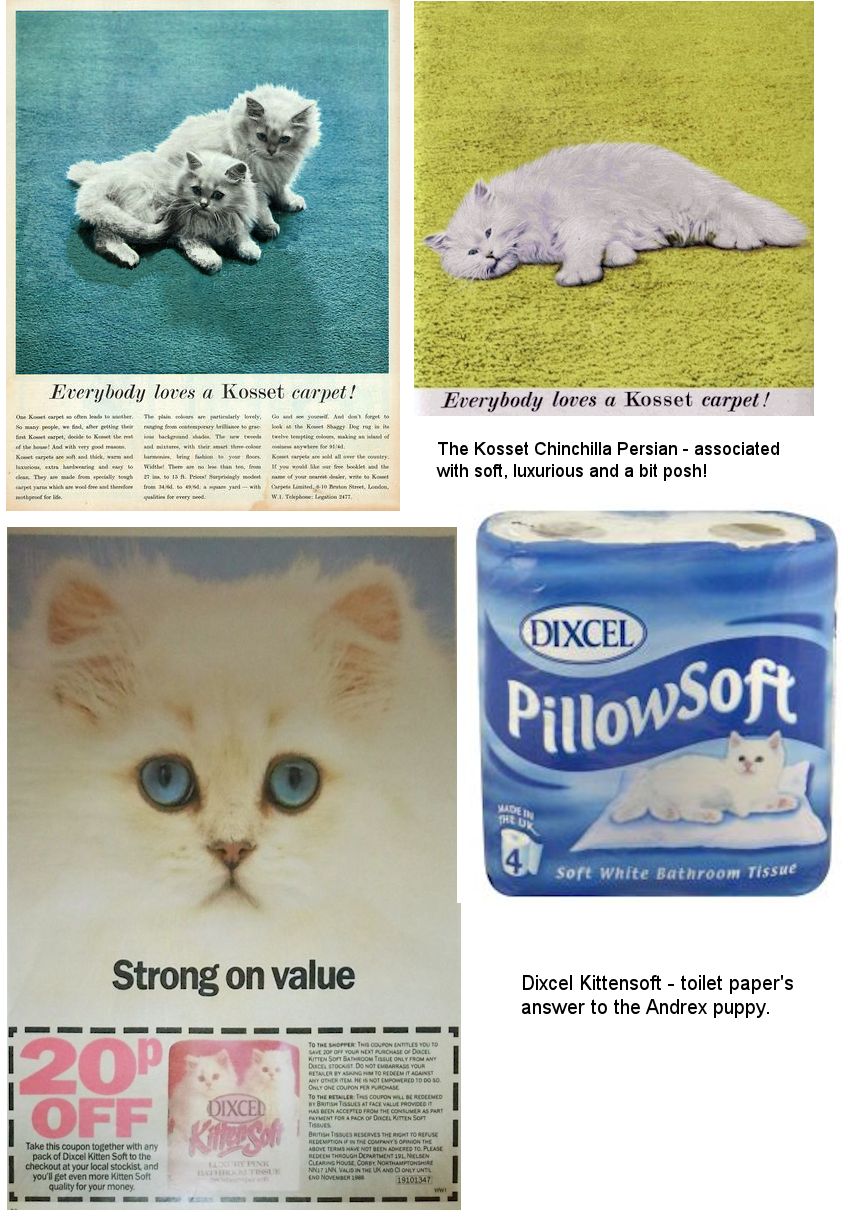
CATS IN ADVERTISING
Images of cats and other animals are used as shorthand in many adverts and on a variety of brands. This plays on how we stereotype certain animals. Menacing hyenas are shown breaking into a car; elephants mean something is jumbo-sized or very tough; wolves are also menacing while big cats conjure up an image of power and/or speed. Owls mean wisdom while flying eagles suggest freedom.
Domestic animals have a variety of images that relate to breeds: Doberman guard dogs contrast with comic scruffy mutts; imperious Persian Longhairs contrast with workmanlike tabby shorthairs. Cute cats and kittens have always been popular as chocolate box and biscuit tin images, so this page looks at specific cats and specific products. It also doesn't include the myriad cat-themed items such as cups, tea-towels, ornaments, clothing etc, nor animal charity adverts. Most of the brands mentioned are those found in Britain as these are the ones I am familiar with. And there's bit of background about some of the companies as well.
WHAT GOES IN ....
The most obvious role of cats in advertising is cat-food. Modern cats do not provide for themselves - if you have a pet cat, you need to buy cat food. Over the years, brands have come and gone (Kattomeat, Choosy, Umami, Purrfect, DeliKat, Kit'n'Caboodle) and the modern trend is niche marketing (kitten foods, senior foods, indoor cat formula, hairball control formula etc). During the 1980s and 1990s, there were several major takeovers and mergers that resulted in once-familiar cat food brands being discontinued or rebranded as the merged companies rationalised their product lines.
In the early 1990s ago I did a study of cat food and cat food advertising. Of the brands then available from supermarkets, only Whiskas did a kitten food and none of the major brands produced senior formula. Nowadays, many supermarket "own brands" have "kitten" and "senior" varieties. What hasn't changed is that some brands are portrayed as more luxurious than others and the main pet food manufacturers have a two-tier or three-tier approach: standard and budget lines; standard and luxury lines or luxury, standard and budget.
The pet food market in the UK is an oligopoly - a few companies each producing several brands that give the impression of a more competitive market. It's difficult for other companies, even the big pet food companies from continental Europe, to break into the market unless they can find a niche. During the 1990s, there was the Munchies dry food brand which later became Brekkies. It used to be available in boxes from supermarkets, but now seems to be sold in sacks and only from large volume retailers. Brekkies is owned by Affinity Petcare, one of the largest pet food companies in continental Europe.
Many cat foods have a signature cat. The Felix cat is black-and-white. Whiskas currently use a silver tabby in advertising and torties or tabbies on packaging; their kitten food uses a ginger kitten. Sheba uses a stylised black silhouette on packaging and a blue shorthair in advertising. Treat food Dreamies uses a tortie-and-white cartoon cat. The Brekkies cat is tabby and white. Tesco's Claude range (a budget range) was a ginger-and-white cat, but has switched to a silver tabby shorthair; Encore (a luxury range) also use a silver tabby shorthair.
Go Cat (a long-established brand in the UK) feature a ginger shorthair; these days he is an active cat and the brand emphasises his healthy weight and activity level. Other Go Cat advertising depicts a ginger cat as a free-runner. Packaging suggests that MeowMix and Friskies are the US equivalents of Go Cat; though the MeowMix name once existed separately as a brand in the UK (the food "cats ask for by name"). In the UK, Omega is the Purina budget brand analogous to Purina Cat Chow in the US. In the UK, Omega is available from large volume retailers, often in self-serve form.
Kattomeat's Arthur, a white cat that ate by dipping his paw into the tin of food, became so well known that the food was rebranded as Arthur's before it vanished altogether. There were rumours (possibly by those supporting competitor brands) that Arthur's teeth had been removed to make him eat by dipping a paw, but paw-dipping is a natural cat behaviour and Arthur had simply been encouraged to use his paw to get a treat straight from the can.
Kattomeat was the sister brand to Kennomeat; canned cat and dog foods launched by Robert Wilson &Sons in the 1950s. In 1964, Spillers Ltd took over the brand names. In 1972, Spillers bought out Hovis's "Stamina Foods" which made the "Paws" brand of cat food. In 1979, Spillers became part of Dalgety plc. In 1992, Kattomeat was renamed and relaunched as Arthurs. In 1995, Dalgety plc also acquired the Felix brand from Quaker and the Arthurs brand was dropped. Then in 1997, Nestle acquired the brand from Dalgety. Spillers also owned the vanished Choosy brand cat food; Choosy was relaunched in 1993, but has since vanished. I think Spillers may also have owned the now-vanished Purrfect brand in the UK; this competed with Sheba.
Quaker petfoods started off in 1966 with Chunky dog food, then acquired Felix Cat Foods in 1970. In the 1980s, Quaker introduced a moist biscuit called Delikat (30% moisture compared to conventional dry cat food's 9%). It was made in chicken & rabbit and shrimp & tuna flavours. TV adverts in the early 1980s showed a cat shunning other bowls of food in favour of a bowl of Delikat. In the UK, Purina discontinued the brand during the 1990s (if my memory serves). In 2007, some North American owners linked the Delikat product to cat deaths caused by tainted dairy ingredients; this may have influenced the decision to completely retire the brand-name.
During the 1990s, the Swiss company Nestle expanded to rival Mars in the pet food market. In 1997, Dalgety sold the Felix brand to Nestle in 1997. In 2002 Nestle took over Ralston-Purina and its pet foods were branded as Purina; however anti-trust laws (equivalent of the UK's Monopolies and Mergers Commission) meant it first had to sell off its MeowMix brand. MeowMix was bought from Nestle in 2001 by Richard C Thompson in partnership with JW Childs Associates; they relaunched it in the USA. The advertising was a version of a karaoke video with a ball bouncing over the words "meow meow meow" (later on, the cats' meows were given English language subtitles). In 2006, Meow Mix in the USA was sold to Del Monte.
Felix, mentioned above (before the brief diversion into its manufacturer’s history), uses a wide-eyed and playful black-and-white cartoon cat that gets up to cute antics because it just can't wait for its food to be served. Felix adverts have portrayed this cat as a mischievous dirty stopout coming home for tea! Felix coupons on packaging can be collected to buy branded goods from the World of Felix.
Friskies Gourmet positions itself as a luxury cat food and has been advertised by an aristocratic Chinchilla Persian being served its gourmet food in a cut glass dish. The sparkling dish mirrored the sparkling effect of the cat's black-tipped white fur. Nestle took over Go Cat in 1985 and Friskies and Go Cat are part of its Purina subsidiary.
The other major pet food company in the UK is Pedigree Petfoods, a subsidiary of Mars. Mars owns Whiskas, Sheba, KiteKat and the now vanished Katkins brand. Katkins was a budget brand. Whiskas use a silver tabby shorthair; the actual breed may depend on where the ad was made - a British Shorthair, a European Shorthair or an American Shorthair. The American Shorthair (which isn't bred in Britain or Europe) is a workaday cat and silver tabby is a popular colour in the breed. Whiskas is therefore a food for all family cats. The British Shorthair is more distinctive as a pedigree breed and the colour perhaps hints at Whiskas being a premium cat food. In Britain, earlier Whiskas advertising used variations on the idea that "8 out of 10 cats prefer it" and showed a cat (not a silver tabby at that time!) walking past other bowls to get to the bowl of Whiskas.
Sheba's advertising started off using a Chartreux, a blue shorthaired breed recognised in Europe and the USA, but not in the UK where it is considered identical to the British Blue Shorthair. These cats are quiet and friendly and the advert suggests the owner is spending quality time relaxing or snuggling with her cat. It has recently changed to using a sleeker Russian Blue and both owner and cat are depicted as active, agile and sensuous
A niche product that doesn’t advertise on TV is "Hi Life", produced by Town & Country Petfoods Ltd; and its niche is "indulgent foods" (the "gourmet" name already being synonymous with Friskies/Go Cat) such as terrines, soft pates or small cans/sachets containing recognisable pieces of fish or meat (probably best known for tuna-based foods). Hi Life also used to produce sachets of semi-moist food in salmon and chicken flavours.
Iams is a more recent brand on supermarket shelves. Seen as a scientifically formulated specialist food, it used to be obtainable only from pet superstores and vet surgeries, often in larger quantities only. Now more widely available, the TV advertising maintains Iams "scientific" image by using a Burmese that intelligently extols the nutritional qualities of Iams dry food, before telling the viewer to check for themselves because "I can't read, I am just a cat". Other high-end dried foods don't currently run TV advertising campaigns, but use a variety of visibly pedigree cats, ranging from Maine Coons to Siamese, in their magazine adverts and on their packaging.
Breeds can be equated with niches: from active moggies to aristocratic longhairs, from everyday shorthairs to intelligent Burmese, the different foods are using breed stereotypes to aim their food at different market niches.
... AND WHAT COMES OUT
Cat litter is less often advertised due to its association with unmentionable bodily wastes. Catsan is an exception and uses a family of pristine white British Shorthairs to advertise how the equally white hygienic cat litter absorbs all odours. In countries with more indoor cats, cat litter is a fact of life for cat owners and may get more advertising time, but in Britain many cats are still expected to use the flowerbed or plain old fuller's earth clumping litter.
A soft-furred fluffy white kitten is used to advertise Dixcel Kittensoft Toilet roll, though it is far less famous than the Andrex puppy. These days, the kitten only seems to appear on the packaging. The problem with kittensoft toilet roll is that it's just too reminiscent of the joke where a bear asks a rabbit if poo sticks to its soft fur and when the rabbit answers "no", the bear uses it as toilet tissue.

INDEPENDENCE, STYLE, COMFORT ... AND SPEED!
Because cats represent independence a silver-tabby shorthair was used in advertising Bacardi Breezer. This cat about town went clubbing - enjoying a night on the tiles before returning home to the concerned owner. Cat owners recognise the dual personality of the cat - a daytime layabout and an active night-time hunter.
Cats are also used to represent domestic comfort - a tabby cat (the stereotypical hearth cat) lounging by a warm fire or radiator for example, or a cat sleeping on furniture. This tells us that the home is a warm and welcoming place to be. In an image of a family, the addition of a snoozing cat tells us that everything is well.

Just as a large hairy dog is associated with a brand of paint, the Chinchilla Persian has been used in advertising Kosset carpets, giving an impression of stylishness and elegance.
With their poise, lithe forms and loose-limbed gait, cats also appear in perfume adverts alongside equally lithe women. This is a long way from the poor "civet cat" (which is not a true cat) whose musky anal secretions were used in perfume. Big cats such as leopards and black leopards (black panthers) are also seen in perfume adverts, hinting at the wearer being alluring and slightly mysterious or at the perfume itself being somehow rare or forbidden. Another brand that uses a wild cat, in its name at least, is Lynx deodorant though the advertising generally features unprepossing young males making themselves irresistible to women by spraying themselves with improbably amounts of the product.
While a black panther represents mystery and a hint of danger, and the lion has a regal bearing, it's the distinctively stripped tiger that has featured in long-running advertising campaigns. The tiger has been used for Kelloggs Frosties where active but amiable Tony the Tiger announces "they'rrrre grrrreat" and also for Esso petrol where a real tiger bounds effortlessly across white sands or stares superciliously from the advert. Esso wanted motorists to put a tiger in the tank i.e. it's about power and performance. During the late 1990s, Esso Tiger Tokens were available when buying Esso fuel and could be traded for gifts from the Tiger Token catalogue.
Unsurprisingly, the cheetah, is linked to fast cars that accelerate fast. However, the Jaguar car doesn't use real jaguars in its adverts only its stylised jaguar logo/bonnet ornament; its image is well-established enough that it doesn't have to. The association of big cats with sporty cars means advertisers only have to hint; images of spots, stripes or the blurred image of a running big cat being enough to suggest a car is sporty. The cars themselves have feline names such as Ford's Puma and Cougar, and Vauxhall's Tigra. Larger four-wheel drive off-roading vehicles (what the Americans call SUVs) may show big cats on tricky terrain to promote the vehicle's road-holding and manoeuvrability.
Rugged or specialist vehicles including snowmobiles and diggers seem more likely to use the names of "rugged" cats such as Lynx and Bobcat - the vehicles, and the cats, are robust rather than speedy. Leyland Buses went through a period of naming types of bus after big cats: Leyland Tiger, Tiger Cub, Tigress, Royal Tiger, Leopard, Lynx, Panther, Panther Cub, Lion, Lioness and Cheetah. Though to be fair, Leyland also produced the Leveret, Badger, Gnu, Panda and Swift.
The "sporty" image of a running or leaping cat is used in the logos of Slazenger (England), Puma (Germany), Black Panther Travel (a coach company in Essex, England) and Claude cat food among others.
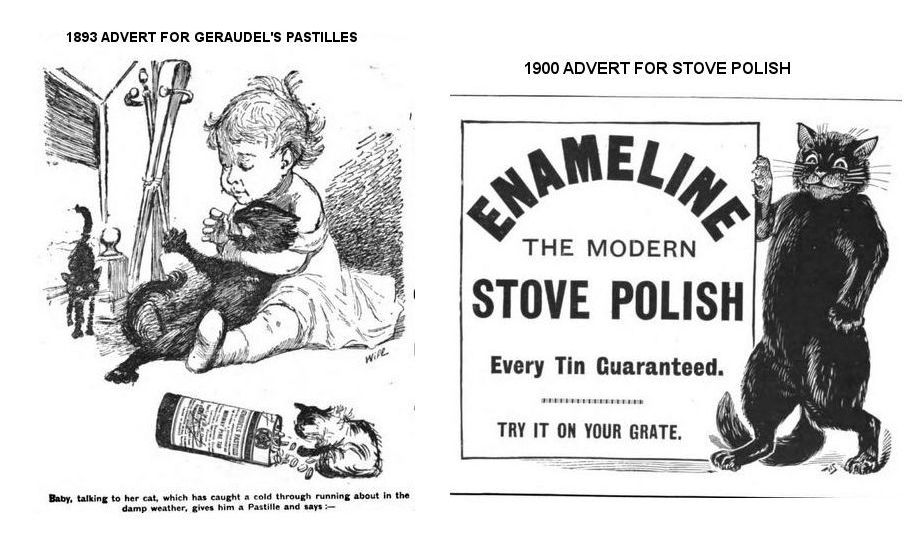
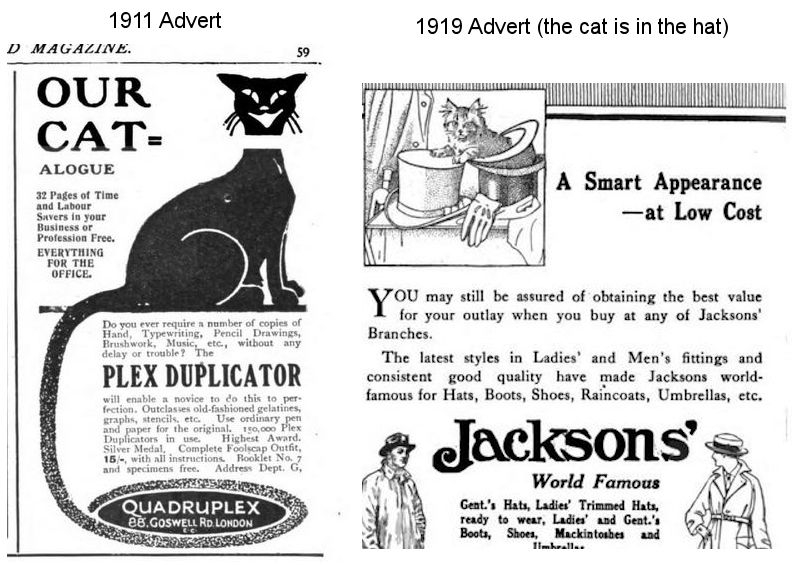
FOOD AND DRINK
The Tate and Lyle brand "Lyle's Golden Syrup" and "Lyle's Black Treacle" tins fascinated me as a child. The tins have a picture of a dead lion with a swarm of bees, and the slogan "Out of the strong came forth sweetness". The image and slogan were registered as a trademark in 1904, making it Britain's oldest brand. It refers to chapter 14 of the Book of Judges in the Bible. Samson was travelling to the land of the Philistines to find a wife. On the way there, he killed a lion. When he passed the same spot on his return he noticed that a swarm of bees had made a comb of honey in the lion's carcass. Samson used this as a riddle at a wedding: "Out of the eater came forth meat and out of the strong came forth sweetness". Abram Lyle was a deeply religious man and may have used the image and slogan to refer to the strength of his company, or of the tin.
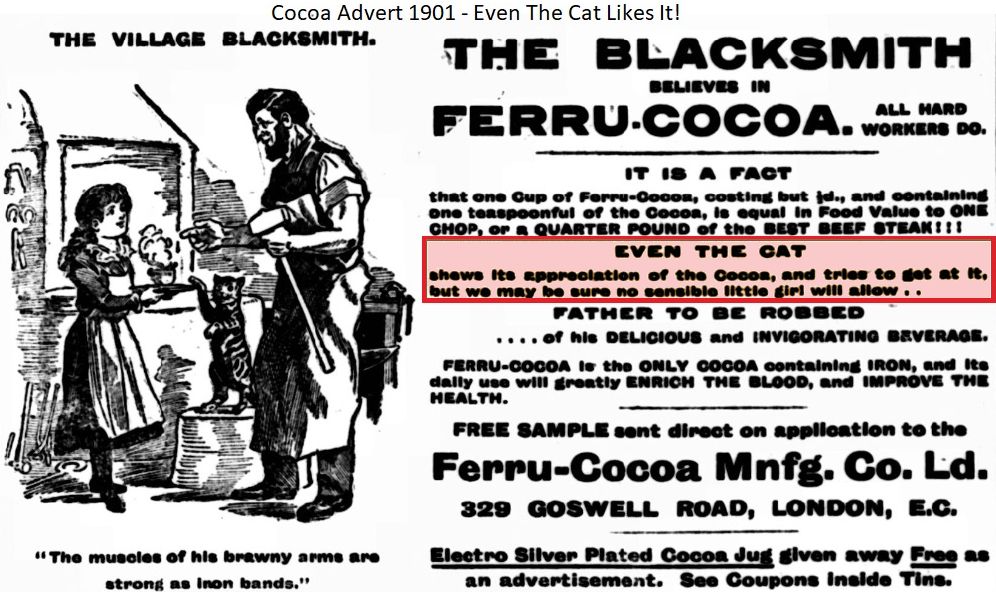
The image of cats loving milk and cream has persisted for decades even though most adult cats are lactose-intolerant. Almost anything edible that is creamy, may include a cat in to emphasise this quality.
Cravendale, whose adverts emphasise the purity of their product, depict polydactyl cats (thumb-cats) attempting to get hold of Cravendale milk. When not trying to raid your home, these CGI thumbed cats can be seen filing their nails, reading and doing other human activities that require opposable thumbs. The Cravendale cats also drive milk-floats and have an army of marching milkmen at their disposal. The campaign has an element of the "Cats and Dogs" spoof spy movie to it.
Crusha milkshake features animated cats jumping around, using gym equipment or playing instruments. These use Joel Veitch's animated cat photos in the style of his cult Ninja Kittens and Viking Kittens found on the internet. And thereby hangs a tale (or tail!) ....
Coca Cola used Ninja Kittens without permission in a TV advertising campaign in Argentina. Independent British band "Seven Seconds of Love" claimed their ska-influenced track "Ninja" (2005) and their distinctive video design were "substantially" copied in the soft drink giant's commercial. At first, Coca Cola's Argentine advertising agency, Santo Buenos Aires, assured the drinks company that nothing was plagiarised. The British band lacked the resources to sue and it was not clear whether a case should be pursued in England (where Veitch creates his animations) or Argentina (where the advertising agency is based). An internet campaign also put Coca Cola under a lot of pressure and they received a lot of negative comments on blogs and message-boards. Eventually, Coca Cola agreed to an out of court settlement and the advert was taken off air. Possibly an ad agency employee thought an obscure British band would never notice the use of their material in a far-away country.
Milk Stout and Cream Stout beers (drinks similar to Guinness) have sometimes used images of cats, alluding to the smooth creaminess of the product. However Pusser's Rum is not related to puss-cats, but is from the slang term for a ship's purser. And there is the Bacardi Breezer silver tabby shorthair mentioned earlier of course.
TOBACCO
Black Cat Virginia Cigarettes and Black Cat tobacco featured a black domestic shorthair cat in its advertising. A number of promotional items were also made featuring the black cat. Black Cat metal advertising signs (a type of advert once common at railways stations) are now collectible and the trademark has a long history.
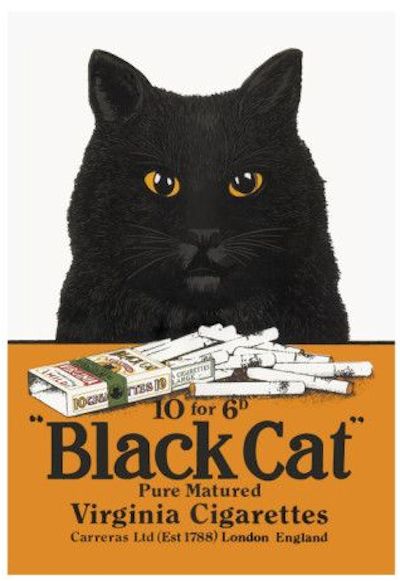
Black Cat was a Carreras (later Carreras-Rothman) tobacco and cigarette brand. The name came from a black domestic shorthair cat that slept in the window of Don José’s shop in Wardour Street, London in the 1870s. This was such a familiar sight that the shop was nicknamed "the black cat shop”. Don José adopted the cat as part of the company's image and in 1886 it became the first trademark registered by Carreras. The cat became an integral part of the design of the Black Cat pack where it appeared in a white circle surrounded by a black border above the initials “JJC” (Don José Joaquin Carreras). The black cat appeared on tobacco tins. Black Cat cigarettes were introduced in 1904 as one of the first machine-made cigarettes manufactured in Britain.
The black cat image was used in the company's cigarette promotions, such as the Black Cat stamp album which was issued free to smokers. The stamps were available inside the cigarette packs and prizes were offered for the best completed albums. Later on the company would introduce collectible cigarette cards. A later free item inside Black Cat cigarette packets was the Black Cat Library of Short Stories in 1909. This was a series of 40 adventure stories. One of the most ambitious promotions was on 18 October 1913: the nationally promoted “Black Cat Day”. Black Cat salesmen would give a golden half-sovereign to anyone they approached in the street who could prove they carried a Black Cat pack.
The popularity of Black Cat cigarettes peaked in the early 1920s. People wore badges and stickers featuring the cat, attended fancy dress parties in black cat costumes and traded Black Cat coupons of items in the Black Cat gift catalogue (just as Esso Tiger Tokens were traded for gifts in the 1990s). During the Second World War, Black Cat was one of the brands that vanished from sale. It reappeared in 1957, but plain cigarettes (i.e. unfiltered) were losing popularity against the filtered brands and it was withdrawn in 1959. It reappaeared as a filter cigarette in the UK in 1976 and survived until November 1993. Due to takeovers and mergers of tobacco companies over the decades, the Black Cat trademark is currently owned by the British American Tobacco Group of companies.
The importance of the Black Cat was such that the former Rothmans premises on Christopher Martin Road, Basildon (later used by a GEC company before being demolished at the end of the 20th century) had a black cat statuette. There was also a black cat statuette at the former Rothman's building in London's West End.
A 1951 ad for Chesterfield cigarettes featured American actress Jan Sterling holding a ginger shorthair cat. The brand was not routinely associated with cats, but had a number of high-profile personalities promoting it at the time. Where they appear as incidental to the brand, cats denote stylishness or may slant the advert towards women.
Samson brand loose tobacco for hand-rolled cigarettes features a lion's head on its pouches, presumably alluding to its rich, strong taste.
CHOCOLATE
Cadbury's Cocoa used an tin sign advertisement of a white Persian Longhair cat listening to a gramophone to promote its cocoa essence. Captioned "A Record of Success" and promoted as "absolutely pure" (hence the pure whiteness of the cat) it also brings to mind the HMV image of Nipper listening to "his master's voice".
When I was a child during the 1970s, there was a strawberry flavoured candy bar called Pink Panther that used the image of the cartoon character.
Rowntrees produce the Lion Bar ("Bite It, Crunch It, Chew It!" was the slogan during my younger days), featuring a lion's head logo on the packaging and advertising. It comes across as a big, strong, satisfying bar.
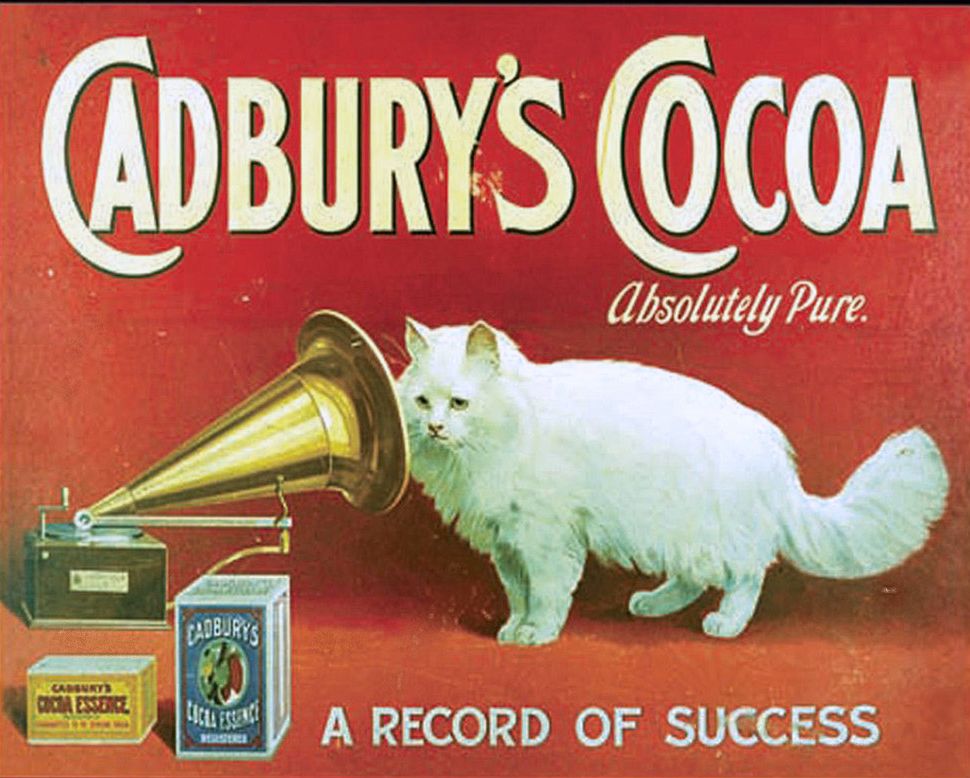
As a slight diversion, Kit Kat, despite its name, has nothing to do with kittens or cats, but took its name from the 18th century Kit Cat Club in London. The club was named after Christopher Catling who was nicknamed Kit Cat ("Kit" rather than "Chris" being the diminutive of Christopher in the time). His pie-shop was used as a political meeting place and his mutton pies were known as Kit Cats. Indidentally, the low ceilings of the club dining room also gave rise to the kit-cat/kit-kat portrait size (for immortalising club members). In 1911, Rowntree's of York trademarked both "Kit Cat" and "Kit Kat" for later use. The name was initially used for "Kit Cat" boxed chocolates. Later the name "Kit Kat Chocolate Crisp", later becoming just "Kit Kat" was given to a four-finger-bar snack. The brand is now owned by Nestle and to my knowledge has never used cats or kittens in its advertising. Not should it be confused with KiteKat brand catfood.
"Kuro Neko" was a Cadbury concept design for the Japanese confectionery market. The design featured an anime black cat (which is what "kuro neko" means) to appeal to children and to pop-art culture enthusiasts in Asia. The associated advertising featured the adventures of an anime black cat as it tried to get a chocolate bar. The overall image was something fun and trendy. The black cat is in the kawaii style - the Japanese cultural concept of cuteness with rounded lines and very simplified features. "Hello Kitty" is a common example of a kawaii cat. The advertising concept also used the lolspeak phrase "nom nom nom". "Nom" is supposedly the sound a cat makes when eating food and meaning either "to eat" or "yum yum" or both depending on context.
TASTES CHANGE
As our tastes change, so do adverts. Cats are now unlikely to feature in western adverts for tobacco products because tobacco companies are so firmly linked to animal experimentation (for example the infamous smoking beagles). Cigarettes are rarely associated with luxury and sophistication, but with addiction and disease.
Long-lived associations such as the Frosties Tiger and the Esso Tiger are likely to prowl on for the foreseeable future, just as the Lyle's lion still survives after more than 100 years. Will kawaii style logos will be as long-lived though, at least outside of Japan? Adverts associated with internet memes, such as kittens animations, will cash in on the meme and then sink once another meme comes along in its place. And big cats will continue to represent strength, speed and sportiness!
As for cats that advertise cat foods, the marketplace, like the jungle, is survival of the fittest. While Go Cat's ginger "Brandon Meow" vanish altogether like white shorthair Arthur or be replaced like the Sheba Chartreux?
You are visitor number